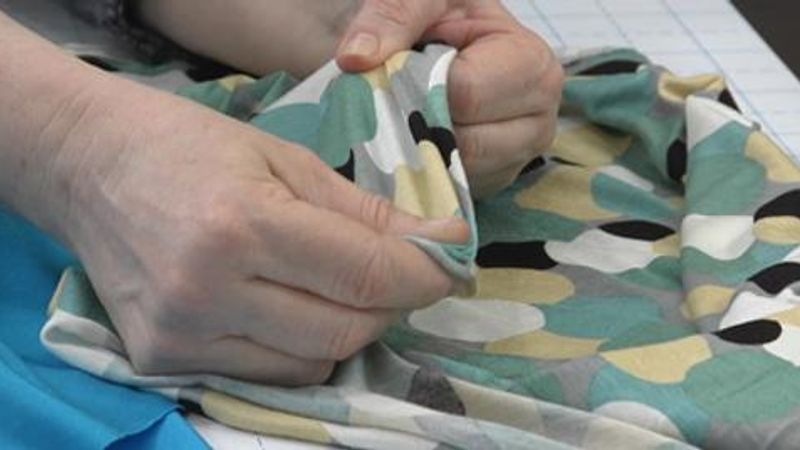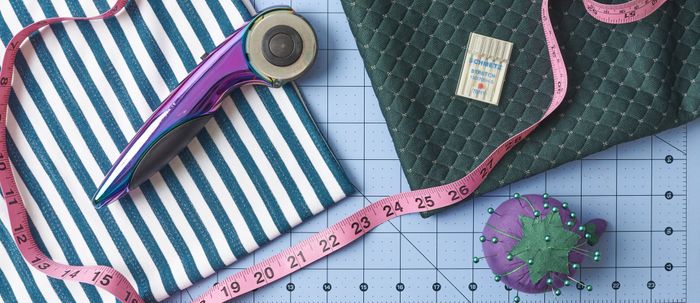
Learn everything you need to know about knit fabric basics, from Judith Neukam, a Threads contributing editor. You’ll find out about the structure of a knitted fabric, which is made from a single strand of yarn, interlocked to create a flexible, inherently stretchy fabric. Machine-made knits range from lightweight jerseys to heavy sweater knits. With knits, you can make everything from lingerie and T-shirts to outerwear, activewear, and even special occasion garments.
Teach Yourself to Sew
Garment sewing expert Judith Neukam got her first taste of sewing when she took the free lessons that came with her mother’s sewing machine purchase. Judith was 9 at the time. Soon after, she was sewing her own clothes and feeding her passion for the craft. In her Teach Yourself to Sew series, Judith shares her enduring love of sewing and her invaluable years of sewing experience.
Getting started
She starts with discussing the equipment and the essential sewing notions for anyone who sews. You’ll learn about shopping for fabrics, choosing patterns (including selecting the correct size), and planning the perfect pattern layout. From machine-sewing simple seams to inserting zippers and stitching buttonholes, Judith demonstrates the key steps to making a custom garment.
Discover methods for clean-finishing seam allowances and applying facings so all edges are neat. To add shape to garments, Judith explains how and why to sew darts, and how to gather fabric for volume. Other garment elements, such as sleeves, pockets, and elasticized waistbands, are shown in easy-to-follow video tutorials.
Advancing your skills
When you’re ready to challenge yourself further, tune in to Judith’s overview of couture garments and sewing techniques. Even if you never intend to become the next Coco Chanel, you’ll learn methods that add quality to your everyday wardrobe. Find out how to perfectly match stripes, plaids, and prints; baste seams; and insert underlinings and linings.
Finally, Judith shares the basics of pattern fitting and adjustment. Her method begins at the shoulders, ensuring the garment hangs properly. Follow along as Judith shows how to create a shoulder template that you can use again and again to adjust patterns before cutting the fabric. As a bonus, you’ll even learn how to create a custom dress form so you can fit garments on a body that truly represents your true body shape.






I am kind of wondering about this video regarding knit fabrics. It seems to be lacking some vital information beginner sewers need to be aware of (which I found out the hard way). It fails to mention anything about the difference in sewing with knit material as opposed to woven, such as the need to use a blunt needle rather than a regular sharp sewing needle; the necessity of using a stretch stitch when sewing rather than a straight stitch (for those of us who have basic machines a zig-zag stitch will work if set at the correct width and length); and nothing is mentioned about the possibility (likelihood) of needing a walking foot so you don't end up with several inches of "extra" top fabric when you reach the end of your seam because the fabric did not feed through the machine uniformly and the pieces are now misaligned and a complete disaster (again, speaking from experience...). Is it possible you might consider including such type of information for those of us who are new to sewing so we don't spend our time and money only to end in tears and feeling like complete failures because we had no idea there was more to working with knit material than this video tends to suggest??
This video is only intended to be an introduction to the variety of knit fabrics available. As it shows, there is a wide range of types, from polar fleece to jersey, lace, sweater knits, and activewear knits with spandex. Each type has its own requirements for successful sewing. For more details on understanding and working with knits, please type "knits" into the search bar; you'll find several articles and videos addressing techniques for handling knit fabrics. As with any textiles, it's a good idea to sew some test seams before constructing a garment. With knits, though, take special care to test seams on the straight grain and crossgrain, as they behave differently.
Carol J. Fresia, Threads Senior Technical Editor
most instructors do not recommend knits for beginners although that’s all I wanted to use when I started. I didn’t want to spend time on cotton projects I would not wear or use.